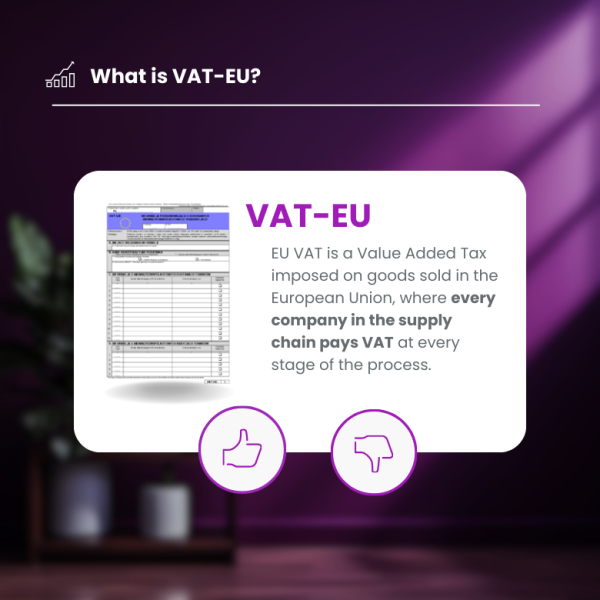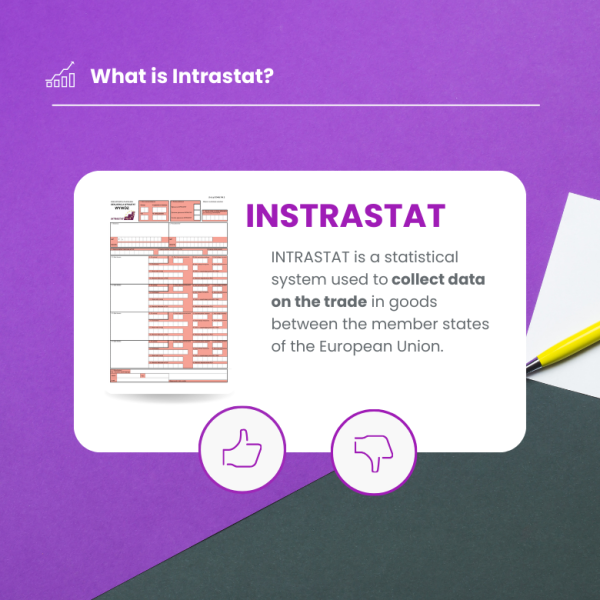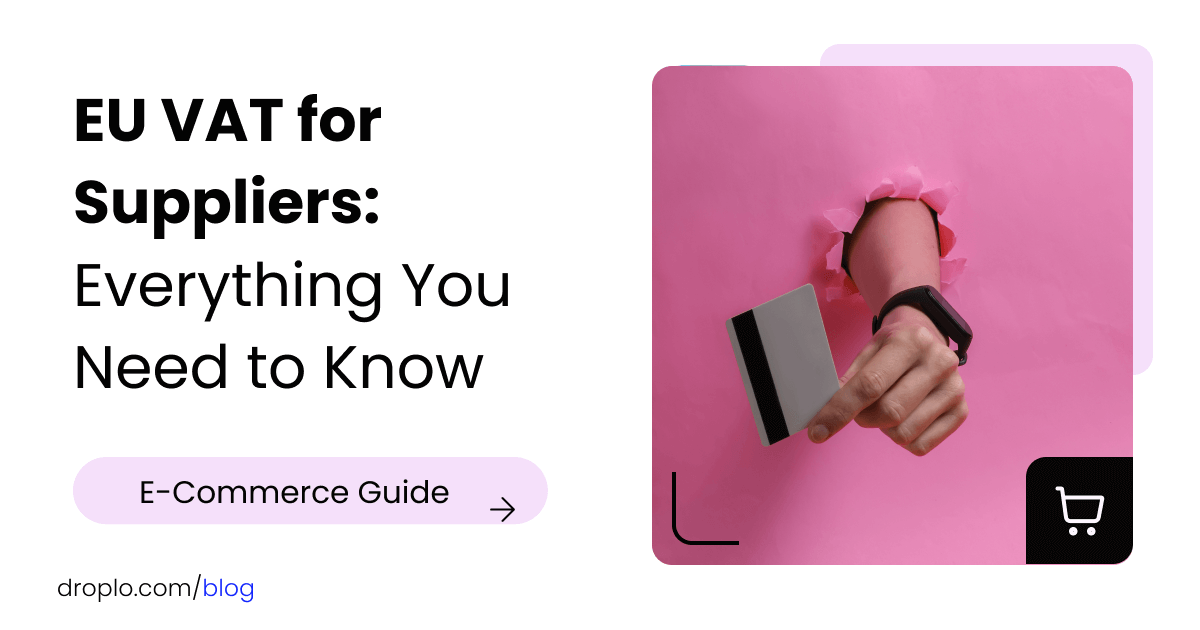Estimated reading time: up to 7 minutes
In today’s world, e-commerce is becoming an increasingly integral part of trade. If you’re a beginner supplier planning to expand your business into the European market, you need to know that using the EU VAT system is essential.
In this article, we’ll show you everything you need to know about registering for EU VAT, VAT rates, reporting obligations, and other aspects related to this topic.
When is VAT registration mandatory and when is it voluntary?
Mandatory VAT registration applies to suppliers whose turnover exceeds certain thresholds. If your turnover in the last 12 months has exceeded a total of 200,000 Polish złoty, you must register for EU VAT.
However, the obligation to register for EU VAT applies to suppliers who want to conduct transactions with counterparts from other European Union countries.
This way, you’ll avoid paying tax in all countries to which you import your goods, deduct VAT on purchase invoices, and even make settlements with counterparts easier

What are the general turnover thresholds in other EU countries?
- United Kingdom: 85,000 GBP (general)
- Germany: 175,000 EUR (general)
- France: 150,000 EUR (general)
- Spain: 600,000 EUR (general)
Remember that these thresholds are current as of May 15, 2024, and may change in the future.
How to register for EU VAT in Poland
To do this, you must fill out the VAT-R registration application. Complete it at least one day before selling or delivering goods. You will receive a response almost immediately. You can do this:
- At the tax office,
- Through the Tax Portal,
- Online at biznes.gov portal,
- At the tax office for larger entities (revenue of 3 million euros +).
What documents do you need?
- VAT-R registration application for goods and services tax,
- Confirmation of payment for the power of attorney,
- Document confirming legal title to the premises,
- General Power of Attorney (PPO-1) or Special Power of Attorney (PPS-1).
How much does it cost?
While the registration itself is free, you can expect an additional fee of 170 PLN for registration confirmation at the tax office and 17 PLN for a special power of attorney (PPS-1).

Registering for EU VAT entails certain obligations. You must submit tax returns regularly and settle accounts with the tax authorities. In the event of errors or irregularities in your accounts, you may be subject to a tax audit.
What are the VAT rates within the EU?
VAT rates within the EU vary depending on the member state. This system allows member states to adjust taxes based on their needs and market conditions.
However, the rates are somewhat complex, as there are four types. Super reduced VAT rates are those below 5%. In addition to the standard and super reduced rates, there are also two versions of the “reduced rate.” Which one you can apply depends on the category of your products.
With 2024, there have been quite a few changes. To simplify your search, we have prepared a comprehensive tax table.
| Country | Normal VAT rate | Reduced VAT rate 1 | Reduced VAT rate 2 | Super reduced VAT rate |
|---|---|---|---|---|
| Austria | 20% | 10% | 13% | |
| Belgium | 21% | 6% | 12% | |
| Bulgaria | 20% | 9% | ||
| Croatia | 25% | 5% | 13% | |
| Cyprus | 19% | 5% | 9% | 3% |
| Czech Republic | 21% | 15% | ||
| Denmark | 25% | |||
| Estonia | 22% | 9% | ||
| Finland | 24% | 10% | 14% | |
| France | 20% | 5.50% | 10% | 2.10% |
| Greece | 24% | 6% | 13% | |
| Germany | 19% | 7% | ||
| Spain | 21% | 10% | 4% | |
| Netherlands | 21% | 9% | ||
| Ireland | 23% | 9% | 13.50% | 4.80% |
| Luxembourg | 17% | 14% | 8% | 3% |
| Lithuania | 21% | 5% | 9% | |
| Latvia | 21% | 12% | 5% | |
| Malta | 18% | 5% | 7% | |
| Poland | 23% | 5% | 8% | |
| Portugal | 23% | 6% | 13% | |
| Romania | 19% | 5% | 9% | |
| Slovakia | 20% | 10% | ||
| Slovenia | 22% | 9.50% | 5% | |
| Sweden | 25% | 6% | 12% | |
| Hungary | 27% | 5% | 18% | |
| Italy | 22% | 10% | 4% | 5% |
Intra-community sales of goods (WDT)
Intra-community sales of goods (WDT) is a transaction in which goods are shipped from one European Union country to another. Suppliers who carry out such transactions must be aware of a number of obligations and requirements.
As a supplier in Poland, you can benefit from a 0% VAT rate when selling goods to other companies in the EU if you meet a few simple conditions.
1. The buyer has an EU tax ID:
Make sure your buyer gives you a valid and correct EU VAT number. This number should contain a two-letter country code (e.g. PL for Poland).
2. Goods leave Poland and enter the EU:
You must have documents that confirm that the goods were shipped from Poland and delivered to the buyer in another EU country. These can be, for example, invoices, consignment notes or customs documents.
3. You are registered for VAT-EU:
Before using the 0% VAT rate, you must register as an EU VAT taxpayer. You can do this using the VAT-R form.
Remember!
- The 0% VAT rate does not apply if you have not submitted the VAT summary information to the EU within the time limit or if this information contains errors.
- However, you can explain these shortcomings in writing to the head of the Tax Office
Intra-Community Acquisition of Goods (WNT)
What is ICA?
Intra-Community Acquisition of Goods (WNT) refers to the situation when you purchase goods from other businesses registered in different EU countries.
If you purchase goods from the EU:
- Account for and pay Polish VAT on the purchased goods.
- Report the ICA transaction in your VAT return.
- You can deduct the VAT shown on the purchase invoice.
When to pay VAT?
You have 15 days from the end of the month in which you received the goods to pay the VAT. If you received the invoice earlier, the payment is due in the month you received the invoice.
ICA does not apply to:
- Goods exempt from VAT, e.g., donations
- Works of art, collectibles, antiques, and used goods if they were legally subject to VAT in the country of purchase.
- Auction supplies if special VAT rules for auctions apply in the country of purchase.
If you are selling one of these three categories, ensure you have documents proving that your goods fall into these categories.
What are INTRASTAT procedures?
INTRASTAT and ECS Procedures
INTRASTAT and ECS procedures are related to the reporting of statistical information. This means that suppliers of goods are required to provide data regarding trade transactions between the member countries of the European Union.
This information includes:
- Date of delivery
- Transaction value
- Type of goods code
- VAT number of the contractor
- Country of origin code of the goods
Reporting thresholds differ by country. How does it work in Poland?
Basic threshold:
- Export: 2,000,000 PLN
- Import: 4,000,000 PLN
Detailed threshold:
- Export: 108,000,000 PLN
- Import: 65,000,000 PLN
To report INTRASTAT in Poland:
You can report in person at the Customs Chamber in Szczecin or online as an XML file. However, you need to create an account on the PUESC platform and have an electronic signature

What you need to know about ECS
ECS Overview
ECS, or the Export Control System, is a set of procedures and regulations that govern the export of goods and technologies from one country to another. The purpose of ECS is to prevent the proliferation of weapons of mass destruction, terrorism, and other threats to national security.
Before Exporting Controlled Goods or Technologies:
You must obtain a special permit, which you apply for from the appropriate public administration authority (in Poland, this is the Internal Security Agency).
What Goods and Technologies Are Controlled by ECS?
- Weapons and Ammunition: Pistols, rifles, bombs, missiles, etc.
- Explosive Materials: Gunpowder, dynamite, TNT, etc.
- Chemical and Biological Materials: Toxic substances, pathogens, etc.
- Nuclear Technologies: Nuclear materials, uranium enrichment technologies, etc.
- Electronics: Electronic components, telecommunication systems, encryption devices, etc.
- Machinery and Equipment: Machine tools, engines, navigation systems, etc.
- Software: Weapon control software, encryption software, etc.
Just in case, document all transactions with controlled goods and technologies — it may turn out that the controlling authorities will ask you to show them.
Where to seek help?
If you need additional assistance with EU VAT, don’t hesitate to use our help. Consult with experts or take advantage of our blog guides available on our website.
Remember, a solid understanding of EU VAT is crucial for the growth of your business in the European market. Therefore, it’s worth investing time and resources in learning and understanding these issues. Good luck!

 Natalia Wiszewska
Natalia Wiszewska 
